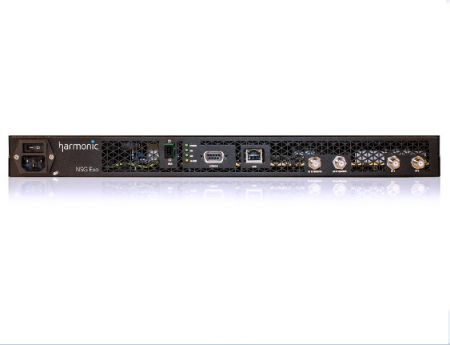Harmonic Seeks Edge With ‘Distributed’ CCAP

Aiming to broaden its pursuit of a budding next-gen cable network market, Harmonic Inc. has introduced the NSG Exo, a “distributed” form of a Converged Cable Access Platform (CCAP) that will eventually pack in the functions of both the edge QAM and the cable modem termination system (CMTS).
By targeting deployments deeper, toward the edge of the cable network, the NSG Exo is designed to complement Harmonic’s NSG Pro, a centralized integrated CCAP chassis that has started out as a super-dense, downstream-only edge QAM that will eventually tack on upstream and full CMTS capabilities. By comparison, the NSG Exo will support the the CMTS component first and add edge QAM capabilities further down the road (the original article, now corrected, had stated that the NSG Exo would support both the CMTS and edge QAM functions upon its commercial release).
“We support CMTS out of the chute and while the hardware supports the EQAM functionality, the software will be available in the future,"Asaf Matatyaou, Harmonic’s director of cable edge solutions, noted in an email to Multichannel News.
The NSG Exo, due out in the third quarter of 2014, will be Harmonic’s first commercially available CMTS.
Harmonic believes this dual-product approach with CCAP will address a broader range of access architectures, allowing for deployments that require highly-centralized CCAPs that serve individual homes and subscribers, as well as more distributed forms that are well-suited for businesses, hotels, college campuses, and apartment buildings, Matatyaou said.
Boiled down, Harmonic is billing the NSG Exo as a low power yet dense device that shifts the RF componentry from the headend or hub to the edges of the operator’s network. It takes digital fiber in, and outputs DOCSIS, MPEG-based video and other RF-based services.
The initial version of the NSG Exo is a 1-rack unit-high indoor enclosure, with a hardened, outdoor unit expected to launch sometime later this year.
Multichannel Newsletter
The smarter way to stay on top of the multichannel video marketplace. Sign up below.
Matatyaou said an NSG Exo can support in the range of 250 to 500 customers, noting that the distributed architecture of the product has not just the potential to serve traditional cable operators but also telcos that terminate fiber to multiple-dwelling units but still need to run services on in-building coax-based network.
He said Harmonic has multiple trials underway with operators “across regions.”
With the NSG Exo, Harmonic is the latest vendor to bring forth a distributed form of a CCAP-based product, though different schools of thought are emerging. Cisco Systems, for example, is pursuing a similar idea that deploys the PHY elements remotely, but keeps the DOCSIS processing in the hub. Gainspeed, a startup, is developing a software-controlled “virtual” CCAP with Juniper Networks and other technology partners that aims to distribute the MAC and PHY, with some processing for DOCSIS and MPEG still occurring in the hub.
Arris has also revealed that it has a virtual CCAP on its roadmap. Aurora Networks, now part of U.K.-based set-top giant Pace, has developed a distributed device called the Node QAM.
They’re all chasing a CCAP market that, according to Infonetics Research estimates, will be worth about $1.7 billion by 2018.
Harmonic said it will show off the NSG Exo at ANGACom, set for May 20-22 in Cologne, Germany.
